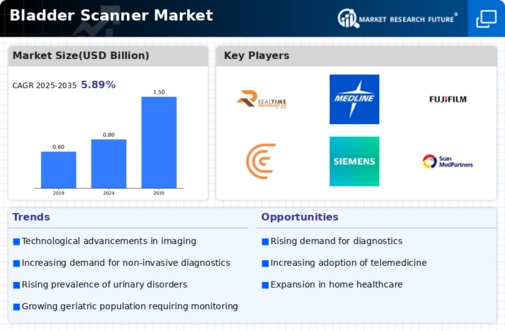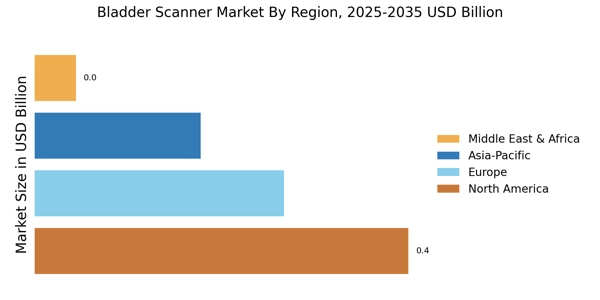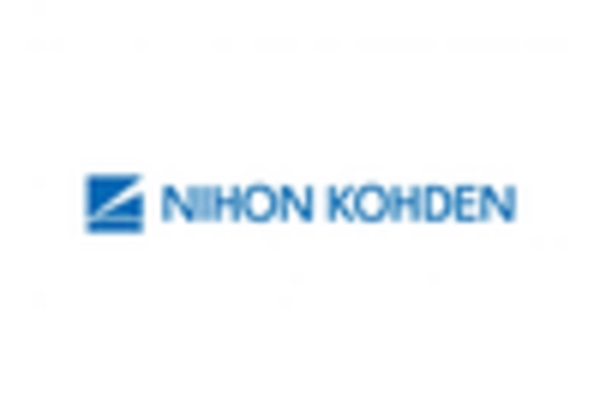Rising Demand in Geriatric Care
The Bladder Scanner Market is witnessing a significant increase in demand driven by the growing geriatric population. As individuals age, the prevalence of urinary retention and other bladder-related issues escalates, necessitating effective diagnostic tools. Bladder scanners provide a non-invasive solution for assessing bladder volume, making them particularly valuable in geriatric care settings. According to recent statistics, the elderly population is expected to double by 2050, which will likely result in a corresponding rise in the need for bladder scanning devices. This demographic shift is prompting healthcare facilities to invest in advanced bladder scanners, thereby contributing to a projected market growth of approximately 9% annually. The emphasis on improving care for the elderly is a crucial factor influencing the expansion of the bladder scanner market.
Increased Focus on Patient Comfort
In the Bladder Scanner Market, there is a notable shift towards enhancing patient comfort during diagnostic procedures. Non-invasive bladder scanning technologies are gaining traction, as they minimize discomfort and anxiety associated with traditional methods. This focus on patient-centric care is particularly relevant in settings such as outpatient clinics and long-term care facilities, where patient experience is paramount. The demand for user-friendly and portable bladder scanners is on the rise, as they allow for quick assessments without the need for invasive procedures. Consequently, manufacturers are investing in ergonomic designs and intuitive interfaces, which could potentially lead to a market expansion of around 10% over the next few years. This trend underscores the importance of patient comfort in driving the adoption of bladder scanning technologies.
Expansion of Healthcare Infrastructure
The Bladder Scanner Market is benefiting from the expansion of healthcare infrastructure in various regions. As healthcare facilities upgrade their equipment and technology, the demand for advanced diagnostic tools, including bladder scanners, is on the rise. New hospitals and clinics are being established, particularly in underserved areas, which increases the accessibility of bladder scanning technologies. This expansion is likely to enhance the overall quality of care provided to patients, as more facilities adopt state-of-the-art equipment. Market analysts project a growth rate of around 8% in the bladder scanner market, driven by this infrastructural development. The investment in healthcare infrastructure is a pivotal factor that supports the proliferation of bladder scanning devices, ultimately improving patient outcomes.
Growing Awareness of Urological Health
In the Bladder Scanner Market, there is an increasing awareness regarding urological health among both healthcare professionals and patients. Educational initiatives and campaigns aimed at promoting understanding of bladder health are becoming more prevalent. This heightened awareness is leading to a greater emphasis on early diagnosis and treatment of urological conditions, which in turn drives the demand for bladder scanners. Healthcare providers are recognizing the importance of accurate bladder assessments in preventing complications associated with urinary disorders. As a result, the market for bladder scanners is projected to grow by approximately 7% over the next few years. This trend indicates a shift towards proactive healthcare measures, highlighting the role of bladder scanners in enhancing patient care.
Technological Advancements in Bladder Scanners
The Bladder Scanner Market is experiencing a surge in technological advancements, which enhances the accuracy and efficiency of bladder volume measurement. Innovations such as 3D imaging and real-time data processing are becoming increasingly prevalent. These advancements not only improve diagnostic capabilities but also streamline workflow in clinical settings. The integration of artificial intelligence and machine learning algorithms into bladder scanners is likely to further refine the precision of assessments. As a result, healthcare providers are more inclined to adopt these advanced devices, leading to a projected growth rate of approximately 8% annually in the bladder scanner market. This trend indicates a shift towards more sophisticated medical equipment, which is essential for improving patient outcomes.


















Leave a Comment